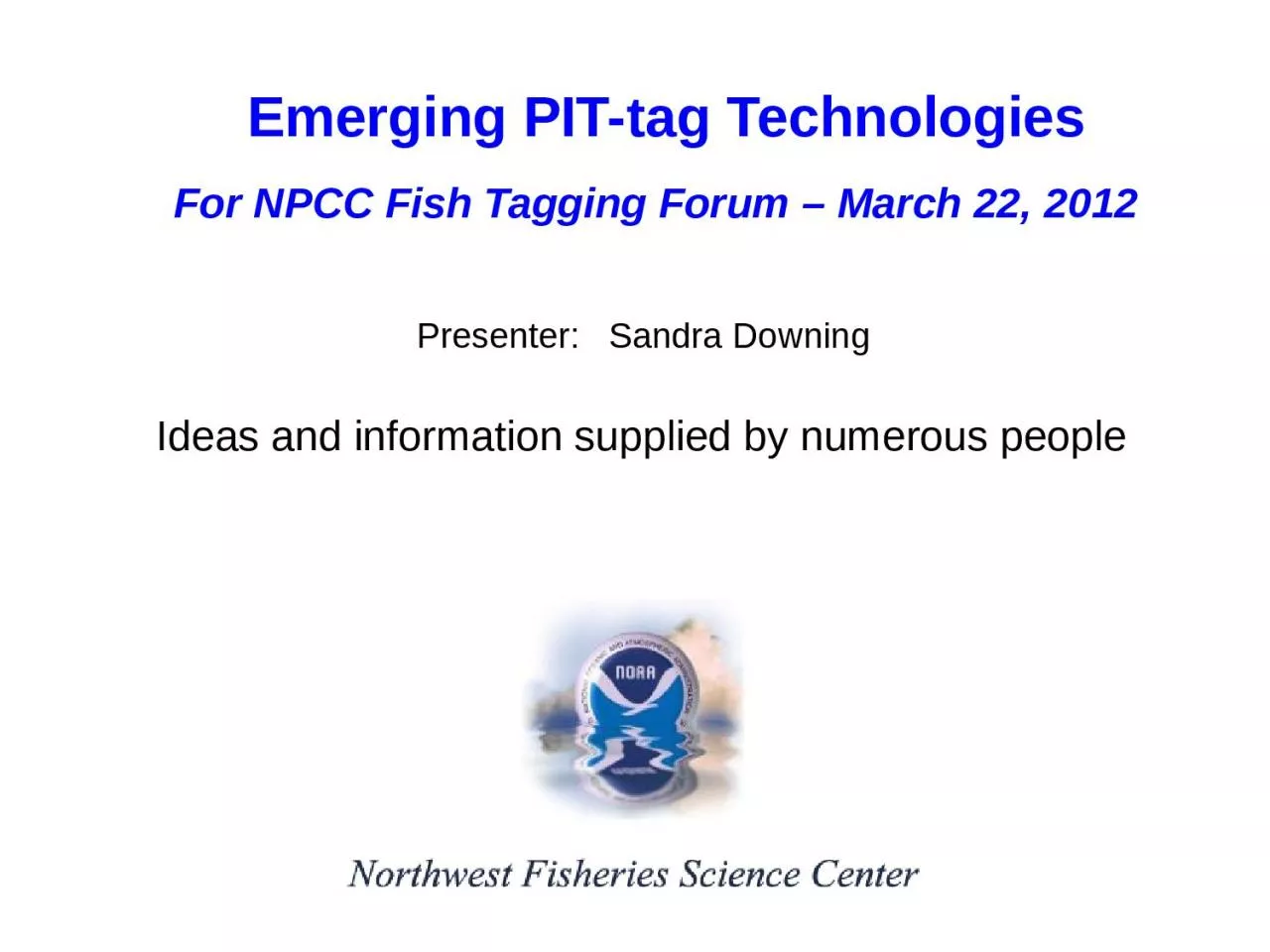

Presenter Sandra Downing Ideas and information supplied by numerous people For NPCC Fish Tagging Forum March 22 2012 Tags Transceivers Antennas Little bit of introduction and history ID: 1039745
Download Presentation The PPT/PDF document "Emerging PIT-tag Technologies" is the property of its rightful owner. Permission is granted to download and print the materials on this web site for personal, non-commercial use only, and to display it on your personal computer provided you do not modify the materials and that you retain all copyright notices contained in the materials. By downloading content from our website, you accept the terms of this agreement.
1. Emerging PIT-tag TechnologiesPresenter: Sandra DowningIdeas and information supplied by numerous peopleFor NPCC Fish Tagging Forum – March 22, 2012
2. Tags Transceivers Antennas Little bit of introduction and history Computer programsOutline of Presentation Examples of emerging and future applications
3. PIT-tag Systems Consist of TagsTransceiversAntennas2001: BE ISO tags FS1001A 2’ x 6’2008: SST ISO tags FS1001M 3’ x 20’ first 9-mm tag Corner collector 17’ x 17’2005: ST ISO tags FS1001M (multiplexing) 2.5’ x 12’Future: 16-msec tags New multiplexing transceiver ogee-passby, 5’ x 25’ or 5’ x 50’(2012) 12-mm HDX Replacement dam transceiver (2020) larger / more antennas shorter/thinner tags Spillway-Ogee and New TI-HDX great 9-mm tag 1999: 400-kHz tags 400-kHz 12” pipe2010: SST-1 ISO tags no new Destron 4’ x 25’ 13-mm HDX Allflex-low power, FDX&HDX 3’ x 10’ better 9-mm tag
4. TagsBPA – New tag contract for 3 sizes of PIT tags Received 18 tag models from different vendors in December 2011 PSMFC and NOAA Fisheries evaluated the tags with laboratory, field, and fish tests 12-mm contract went to the same Destron SST-1 tag (now being sold as Biomark tag)9-mm tag 9-mm contract went to RFID Solutions S.L. (detection rate was 54% in the BCC system vs 12% for best Destron 9-mm) Tag costs reduced with new contract 23-mm contract went to Biomark
5. 16-msec tags (7-9% higher detection at BCC)TagsAdditional new PIT tags New 12-mm HDX tags (improved over 13-mm prototype) Slender 8-mm x 1.25-mm tags (12-mm: 30% volume and 24% weight at .024g) Many small tags now available(smallest 7-mm x 1.25-mm tags had disappointing performance)
6. Tag or Tagging Effects 12.5-mm tags have been shown in several studies to negatively impact SARs Do smaller tags have less of a negative effect? NOAA Fisheries is designing an experiment to evaluate this in Alaska with its higher SARs Lost or shed tags / higher mortality (if so how much higher)
7. Future for Tags I think we will see anti-collision firmware that will make it possible to detect multiple tags that are in an antenna’s field simultaneously. 9-mm tags to replace 12.3-mm tags as standard size? Ability to kill or temporarily disable tags (e.g., collecting tag data from avian predator populations)
8. TransceiversBiomark (nee Destron Fearing) Ogee transceiver 2020 transceiver – replacement for transceivers at dams, ISO New multiplexing transceiver On-going Developments NMFS and Allflex Improving system performance for low-powered Allflex board
9. Spillway Detection - Ogee transceiver Powerful - capable of creating field 4-5’ deep in passby mode Possible replacement for corner- collector transceiver (i.e., it will be able to operate very large single antennas) Can detect the 16-msec tags 25-35% of tagged fish returning have no juvenile passage info
10. 2020 transceiver Designed to replace the FS1001J, FS1001A, and FS1001AB at the mainstem dam sites with a single transceiver model Auto tuning Diagnostics needed to help PSMFC maintain its high operational standards Several communication ports (ethernet, fiber optic, USB) ISO transceiver, so reads both FDX and HDX Will be installed and tested in 2012 Currently will not work for smaller antennas
11. New multiplexing transceiver Auto tuning Substantially better read range Can sync master controllers Same power consumption as MUX for 6 antennas Up to 12 antennas
12. NOAA Fisheries will be testing final prototypes during first week of AprilNew multiplexing transceiver
13. BiomarkTexas Instrument New handheld or portable readerTransceiversFuture Developments Low cost multiplexing transceiver New reader for HDX tags
14. AntennasAs in the past, once we have new transceivers, we will learn how to push them to maximize antenna size and learn how to use them for new applications. For example, new multiplexing transceiver will require less of an air gap in its antennas than the MUX.
15. Tests of a 50’ long antenna with prototype ACN transceiver(new meaning to it’s in the back of the truck)
16. Emerging and Future Applications Lower Granite DamSpillway Detection Goal is to install for 2014 TSW into Bay 2 as backup for RSW in Bay 1 Lower Granite Dam’s ogee is very different from Ice Harbor Dam’s Tag collisions are a big issue for spillway detection Detection rate is a big unknown Antenna read range want 48-60”
17. Emerging and Future Applications
18. Emerging and Future ApplicationsJuvenile lamprey
19. Cougar DamPurpose is Flood ControlMany lack fish passagewaysEmerging and Future ApplicationsWillamette Basin
20. Computer Programs M4 program for interrogation data More incorporation of meta data into fisheries database(s) Better web-based tools that allow for more complicated and faster analyses M4 program for performing separation-by-code
21. What PIT-tag tools do researchers or managerswant to see in the future to improve managementof the fisheries resources?